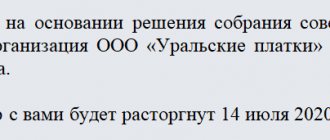Responsibilities of the employer when reducing the number of staff or liquidating the organization
The employer's responsibilities, guarantees and compensation for employees upon termination of the activities of a company or enterprise are prescribed in Article 180 of the Labor Code of the Russian Federation. In accordance with the above article, the employer is obliged to offer the employee another vacant job. This may be fulfilling the duties of an employee who is on sick leave, or on parental leave or a long business trip.
The employer must specify in the offer all job responsibilities and salary for the proposed position. During the entire period of notice of dismissal, he must offer the employee all possible vacancies.
It is worth noting that the employer is obliged to notify the employee of the upcoming dismissal no later than two months before the reduction of staff.
The warning sheet must necessarily contain a signature and the date when the employee became familiar with the notification. If the employee refuses to sign the notice, it is necessary to draw up a report. The period established by law - two months - begins to be calculated the next day after the act is drawn up. This condition is not considered fulfilled if the notice of dismissal was announced at a general meeting and not individually.
An employee who finds himself temporarily unable to work due to illness during the notice period does not have the right to demand an extension of the period.
Required documents
First of all, an order is needed to dismiss each employee of the organization.
The order must be delivered and signed by all employees.
This type of document should be filled out in accordance with the form approved by the Federal State Statistics Service (form T-8).
IMPORTANT ! When drawing up an order, the employer must take into account that the time period from the date of notification of dismissal to the date of immediate reduction must be at least two months.
A member of the liquidation commission has the right to sign such an order. After receiving the signature, the document is recorded in the registration journal. Then each employee signs the original document, which confirms familiarization with the order. All company employees are required to receive a copy of the document.
REFERENCE ! The absence of any signature of the employee (upon notification, familiarization or on the receipt) is unacceptable!
The final stage of reduction in connection with the liquidation of an organization is the registration of work books. The owner of the organization, who has the authority to terminate the employment agreement, enters in the book the serial number, date and reason for the dismissal of the employee, as well as the grounds as a result of which the dismissal was made.
When liquidating an enterprise, dismissal occurs on the basis of the first paragraph of Article 81 of the Labor Code . The book is returned to its owner against signature in person directly on the day of the layoff, or in some cases sent by mail.
Employee rights during liquidation or staff reduction
The employee must be warned about the upcoming dismissal due to a reduction or cessation of the organization’s activities no later than two months before the date of termination of the employment relationship.
The employee must be offered a transfer to existing vacant positions at the enterprise. This also applies to all jobs of temporarily absent workers.
On the last working day, the employee must be paid in full, which consists of wages for the period worked, compensation for unused vacation days and redundancy benefits.
It is worth noting that monthly benefits are required to be paid to women who, at the time of liquidation of the organization, were on maternity leave and do not receive unemployment benefits.
Article 178 of the Labor Code of the Russian Federation provides for the receipt of an average monthly compensation payment to employees for up to three months if they have not found a new job by joining the labor exchange no later than two weeks after the date of dismissal.
General provisions and sequence of actions
One of the most important stages when terminating the activities of an enterprise is formalizing the dismissal of the people who worked there. This process almost completely coincides with the process that takes place when it is necessary to denounce employment contracts during layoffs. But there is one key difference between these situations. Some groups of citizens, according to the law, cannot be dismissed due to reduction. These categories of the population are:
- pregnant women;
- single parents;
- combat veterans, etc.
However, upon termination of the enterprise, the employer has the right to dismiss any employee, regardless of his social status.
That is, during the liquidation of an organization, the employer has every right to terminate employment relationships with citizens belonging to the categories listed above. But such a right arises only upon the final termination of the enterprise’s activities.
When the organizational form of an enterprise changes, it is divided or merged, some employees may retain the right to retain their positions. Persons in the categories mentioned above have labor guarantees and are not subject to dismissal. The availability of the right to retain jobs does not depend on the type of reorganization. Upon final liquidation of a legal entity, management should take the following steps:
- You should start by notifying the state employment service about the upcoming liquidation of the enterprise and staff reduction.
- Then you should officially notify all employees of the organization about the upcoming dismissal due to the termination of the existence of the legal entity.
- An order is signed to reduce the entire workforce of the enterprise. After signing it, all documents begin to be processed in the HR department. The personal files of former employees are closed.
- Now you can recalculate and pay severance pay.
Only after completing all of the above procedures, an entry about the dismissal of an employee during the liquidation of an enterprise can be entered into the work book.
If the procedure involves the dismissal of not only employees, but also managers at all levels, then in this case the general director of the company also falls under the reduction of employees during the liquidation of the enterprise. In such a situation, the procedure for his dismissal is carried out by a third party. This may be a temporary manager, or, if the company is liquidated through bankruptcy proceedings, an arbitration manager appointed by the court.
Regulations for staff reductions
The procedure for reducing staff in an organization is strictly regulated by the Labor Code of the Russian Federation. It takes place in several stages:
- The first step is to determine the list of positions that are subject to staff reduction.
- An order is issued that contains the timing of the reduction and the number of jobs that are subject to reduction.
- The employer does not have the right to decide independently, without relying on labor legislation, which employees are laid off. When downsizing, preference should be given to employees with high qualifications and labor productivity.
- No later than two months before the date of reduction established by the order, the employee must be notified in writing individually. The notification sheet must be signed and dated by the employee. A notice of dismissal given at a general meeting has no legal force. This is a violation of the regulations.
- The employer must notify the employment service authorities and the trade union organization in writing about the planned reduction.
- The employer offers the employee available vacancies at the enterprise.
- On the last working day, the employee is given a work book with all the necessary entries. In case of refusal to receive a work book, personnel department employees send it by registered mail to the employee’s place of residence.
- The employee retains his average salary after termination of the contract for the next two months. If an employee joined the employment exchange within 14 days after the termination of the employment relationship, his average earnings are retained for another month.
In the case where the productivity of several employees is the same, but you need to leave one, preference should be given to:
- employees who have two or more dependent family members;
- workers who no longer have working family members, and this income is the main means of subsistence;
- an employee who was injured at this enterprise;
- disabled people of WWII and combat;
- employees who improve their skills in this area without interruption from production.
What do you need to know about employee notification?
Article 180 of the Labor Code states that notification of employees about the upcoming layoff due to the termination of the organization’s activities must take place no later than 2 months before the event.
If the employment contract was signed for a period of up to two months, the employer has the right to notify about this at least 3 calendar days in advance - Article 292 of the Labor Code.
If the organization has employees hired for seasonal work, they must be notified at least a week before layoffs - Article 296 of the Labor Code of the Russian Federation.
In the event that an employer requires early termination of an employment contract, he must obtain a written agreement from the employee himself. At the same time, the employer is obliged to pay additional compensation equal to the average earnings relative to the remaining time before the expiration of the notice of dismissal.
The employer will be able to save on this payment if the employee is laid off on other grounds. These include transfer to another organization - paragraph 5 of Article 77 of the Labor Code, dismissal at one's own request - paragraph 3 of Article 77 of the Labor Code of the Russian Federation and Article 80 of the Labor Code of the Russian Federation, dismissal by agreement of the parties - paragraph 1 of Article 77 of Article 78 of the Labor Code of the Russian Federation.
The process of liquidating an organization and informing employees
During the liquidation of an organization, all of its employees are subject to dismissal. Each stage of the procedure is strictly regulated:
- the first stage is the mandatory notification of the employment service about the liquidation of the enterprise in writing;
- Notifying employees within the time limits clearly established by law - no later than 2 months. Information about the liquidation of an enterprise must be in writing; this can be done through a trade union organization.
- The last stage is drawing up an order and making entries in work books.
An employee upon dismissal for reasons of liquidation of the organization has the right to the following compensation:
- receiving wages for all days worked, including the day of signing the order and issuing a work book; compensation for days of unused vacation;
- one monthly salary upon dismissal and one salary for two months;
- if an employee joined the employment exchange no later than two weeks after dismissal, he is entitled to payment within three months. All payments are made strictly on the day of dismissal.
The work of a "personnel officer"
When closing an enterprise, HR department employees about the upcoming mass layoff:
- notify the employment service;
- send notification to trade union organizations;
- are communicated personally to each employee.
In addition, they prepare dismissal orders and make appropriate entries in work books. Let’s take a closer look at how to do this correctly and what the consequences for inaction are.
Both the Employment Center and trade union organizations must be notified in advance of mass layoffs. This must be done three months before the workers lose their jobs. There is no special form for such notification. The text can also be written in free form. It is important to follow the style of the message and send it to the recipient on time.
If the deadlines are violated, both the organization and officials, in accordance with Article 19.7 of the Code of Administrative Offenses of the Russian Federation, will be punished by a fine. A legal entity will have to pay from 3,000 ₽ to 5,000 ₽, an official - from 300 ₽ to 500 ₽.
Guarantees and compensation for workers
Employees have the same compensation both in case of liquidation of the organization and in case of staff reduction. All payments must be made strictly on the day of dismissal. The employee has the right to receive compensation for all vacation days remaining at this enterprise. Employee guarantees during layoffs are strictly enshrined in law.
When staffing is reduced, the employee must be offered available vacancies at the enterprise.
If an employee is dismissed due to the liquidation of an enterprise or a reduction in the number of employees, he has the right to register with the employment center and receive compensation payments amounting to at least the average monthly salary within three months after termination of the contract. Upon termination of the employment contract, the employee must be compensated for all remaining vacation days.
Author of the article
Payments to employees
The dismissed person must receive the payments due to him by law:
- due salary;
- money for unfulfilled vacation rights;
- severance pay - average monthly earnings (without bonuses, etc. payments). Seasonal workers receive half as much.
But that's not all.
The dismissed person must receive severance pay for another two months. And in cases where an employee applied to the Employment Service in the first two weeks after the termination of his employment agreement, but did not get a job, he must be paid severance pay plus another month.
Responsibility of the employer of the organization
In the event that the employer did not consider it necessary to respect all the rights of the organization’s employees or violated the terms or rules of notification, as well as other requirements prescribed in the Federal Law, the employee whose rights were violated may appeal to a judicial authority.
Then, if the guilt of the first is proven, the employer will have to bear an administrative penalty. Namely, he will be obliged to provide the employee with a new job and pay compensation for moral damage.
Reduction of staff due to the termination of the activities of a legal entity is a complex and time-consuming process. Therefore, you should not neglect the requirements and recommendations in order to avoid even greater difficulties.
Certain categories of workers
It is always clear how the reduction of the company's management is carried out, because... There are practically no individual situations here. However, in other cases, not all people may be fired.
There are some categories of workers who do not fully fall under the general rules - they can be laid off, but only with the subsequent selection of a new job.
Among such workers the following categories are distinguished:
- Women who are pregnant or have a child under three and under six years of age. If the child is not yet three years old, the woman is most likely on maternity leave. If his age is from three to six years, but there is still a need for maternity leave, this must be confirmed by appropriate documentation.
- Single mothers who have a child under the age of fourteen or who has a disability. Single mothers are:
- women who do not have a husband, who have a child’s birth certificate that does not contain the father’s name or, at the request of the mother, has a corresponding mark;
- widows;
- women who are divorced and raising a child (the condition of providing alimony is not taken into account).
- Single fathers (the mother may undergo long-term treatment) or adoptive parents.
- Workers who have not reached the age of majority. Here, certain work must be carried out with employees of the service dealing with children’s affairs, namely, obtaining their consent.
In what cases is it carried out?
No one will refuse a successful business that generates profit, so liquidation is generally carried out only if business activity implies a complete lack of profit.
Moreover, the specified measures are taken when the current costs of maintaining the same equipment and staff are many times higher than the profit received - this means that the company is working to its detriment.
Voluntary and forced
It is worth noting that the grounds for termination of activities may also be other reasons initiated both by the owners of the institution themselves and by competent organizations related to the authorities.
In particular, a company may be liquidated:
- voluntarily by decision of the founders, for example, if one of them leaves, and therefore takes away part of the main fund;
- in the event that the enterprise is in bankruptcy due to the lack of profit and the ability to repay current payments both in relation to government agencies, the same tax or pension fund, not to mention suppliers and other creditors;
- in the event that the continuation of economic activity even through additional financial influences does not have prospects, which is important when the competitiveness of the products produced decreases or for other economic reasons.
But the forced liquidation of a company can be carried out by a court decision in connection with the same violations of the law or the lack of permits for carrying out certain types of activities.
For example, this is possible if the Management Company was deprived of its license due to failure to fulfill its obligations and non-fulfillment of the terms of the agreement concluded with residents of the reporting houses.
Employment assistance issue
When some employees are dismissed, mandatory re-employment is required. This category includes not only pregnant women, but also women raising children under the age of 3 years.
There is a requirement that such women cannot be fired until they are properly employed. Thus, the employer is responsible for the dismissal of such an employee.
The following employment options are available:
- self-employment;
- employment through the employment service department;
- employment through the sale of assets to another company.
Self-employment is the easiest option for an employer. In this case, we may be talking about employment at another enterprise that belongs to the owner.
If the employer does not have the opportunity to place such an employee, he has to contact the state employment service. In this case, the employee will be offered several suitable job options.
If the assets of a liquidated enterprise are sold to another company, they may be transferred along with such employees. As a rule, this procedure is not difficult if the new company has a suitable position.
Note! It is necessary to obtain proof that the employee is employed. This can be a copy of the work record, which is certified by the seal of the new employer.
But there are situations when such an employee refuses all offers, even if they are beneficial to him.
In this case, you must take the following steps in advance:
- at the time of reading the notice of upcoming dismissal, it is necessary to request written wishes regarding a new job, although this is not necessary;
- all proposals must be offered in writing under a personal signature;
- all refusals must be taken in writing with explanations of the reasons for the refusal;
- it is necessary to draw up an act stating that the employee refused all the proposed options.
Still, it is important to come to an agreement. This is due to the fact that in case of violation with dismissal, a labor dispute may arise
As a result, liability for violation may occur.
Who makes the decision on liquidation?
The basis for dismissal of employees in connection with the liquidation of an organization (“closing” of an individual entrepreneur) is the decision to liquidate the legal entity (termination of the activities of the individual entrepreneur).
The decision to liquidate an organization can be made:
- founders (participants, shareholders) of a legal entity or its body authorized to do so by the constituent document (clause 2 of Article of the Civil Code);
- by the court, including if the company is declared bankrupt (clauses 3 and 6 of Articles of the Civil Code of the Russian Federation).
The procedure for dismissing employees due to the liquidation of an organization is the same in all of the above cases.
IMPORTANT
An organization is considered liquidated after its exclusion from the Unified State Register of Legal Entities. However, the dismissal of employees is not related to the date of entry into this register. Termination of contracts is possible after a decision on liquidation has been made by the founders (authorized body) or the court (i.e., before the legal entity is removed from the register).
Submit documents for registering an LLC/IP or making changes to the Unified State Register of Legal Entities/Unified State Register of Individual Entrepreneurs via the Internet
REFERENCE
In some cases, tax authorities can independently (i.e., without an application from an organization or individual entrepreneur and without a court decision) exclude an inactive taxpayer from the Unified State Register of Legal Entities or Unified State Register of Individual Entrepreneurs. For more details, see “Starting September 2021, tax authorities will be able to “close” inactive individual entrepreneurs.” In our opinion, in such situations, employment contracts with employees must also be terminated on the basis of clause 1 of part 1 of article of the Labor Code of the Russian Federation (i.e. in connection with the liquidation of the organization or the “closure” of the individual entrepreneur). This, in particular, follows from paragraph 2 of Article 64.2 of the Civil Code of the Russian Federation. It states that the exclusion of an inactive company from the Unified State Register of Legal Entities entails legal consequences provided for by laws in relation to liquidated legal entities.
Receive a fresh extract from the Unified State Register of Legal Entities or Unified State Register of Individual Entrepreneurs with the signature of the Federal Tax Service Send an application
Employee benefits
A person can count on receiving the following payments in connection with a reduction during the liquidation of an enterprise:
- Full payment for all those days that the employee worked. Average monthly earnings are divided by the number of working days worked by the employee in accordance with the employment contract. After this, the days until the company is dissolved are counted and the indicator is multiplied by the resulting figure.
- Payments for vacation days that were not used. In accordance with the regulations governing the calculation of vacation pay, the average salary for making payments for unused vacation is calculated by dividing the employee’s earnings for the last year by 12, and then by the average number of working days in one month.
- Providing severance pay as an average salary. The calculation is carried out by adding a person’s monthly salaries, which are then divided by the number of months.
- Making payments if the employment contract was terminated before the due date. The employer issues funds to employees in the amount of one day's salary multiplied by the number of days remaining until the day of notification of staff reduction.










